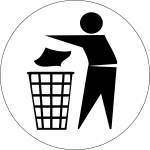Learning the mechanics of pushing a piece of corporate content through a content management system and onto the intranet is only part of the skills required to be an intranet publisher. Creating quality material that is engaging, findable and useful to staff is equally essential so that the intranet does not become a place for trash.
In addition to CMS training, we also offer staff a workshop/course entitled how to improve your online presence. It’s a 4 hour course split into 7 sections, with powerpoint slides and plenty of written and practical exercises.
Psychology of users
I start the workshop by focusing on the end user, emphasising that the reason we create and publish intranet material is so that someone can read it, use it, interact with it. I use a lot of Steve Krug’s material in explaining how staff read and search for intranet pages, how they are pressed for time and don’t read pages completely from top to bottom. I quote actual intranet statistics and illustrate, for example, that staff spend just over 1 minute on average in any “visit” to our intranet.
Writing for the web and plain English
The next section of the course gets down to raw writing skills and introduces editing, chunking and plain English writing techniques. Practical exercises, based on real corporate intranet material where possible, help participants to brush up their writing and editing skills, lower their word count, remove passive voice, be objective and use a consistent tone of voice which talks to the reader.
Accessibility
A condensed version of the W3C WAI priority checkpoints covers the main do’s and don’ts, including a practical exercise where participants have to close their eyes and I play the part of the screenreader software and shout out a list of “click here” and “read more” type of hyperlinks, and then ask participants to choose a specific link when trying to find a particular page. I also introduce ALT tags and how best to describe photo images to users who can’t see them.
Search engine optimisation
The next section explains how the search engine crawls and indexes HTML pages and binary documents (DOC, PDF, XLS…) I then talk about what we can do to help the search engine and ultimately our staff. I place great emphasis on the importance of page titles (especially in binary docs). I show good and bad examples of search results and a practical search engine optimisation exercise gets publishers into the habit of always checking metadata.
Image optimisation
You wouldn’t think that it is possible to get so many things wrong when dealing with graphics. Here are some of the bloopers that I’ve had to address:
- stretched and distorted images that have been resized in HTML
- enormous file sizes because images aren’t optimised (I’ve seen thumbnail images that are 2MB in size!)
- horrible grainy four-colour JPG logos which should have been converted to GIF or PNG format
- group photo shots, so small that you can’t recognise faces
- dull and lifeless images which could use some colour correction
Analytics and evaluation
Housekeeping
In this section I cover file and folder naming conventions, awareness of the live server and the development environment, removing old content and files, and other tips to keep a tidy house.
Background
I designed this course with our intranet publishing environment in mind. We don’t have intelligent intranet software or a modern CMS system and as such, our publishing environment is very much manual, requiring publishers to think for themselves. I’m well aware that more modern publishing systems will automatically do a lot of the tasks I’ve described above, such as resizing and cropping image thumbnails and maintaining document version control.
Results
I have run this course many times across different departments and it always gets good feedback. Although it’s a bit of a long slog, the exercises keep people awake. Publishers leave with greater awareness of both the “content” and the “user” sides of the intranet.
Not everyone puts into practise what they have learned. And we still have to bow down to the HiPPO effect (Highest Paid Person’s Opinion). It’s never perfect but, on the whole, search results have improved and the intranet remains free from clutter.
